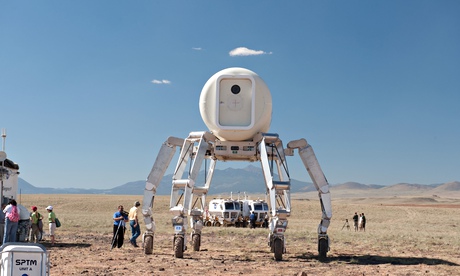
Now commonplace, game controllers are so familiar in scenes of living-room clutter that they have, with the exception of when they are hurled wall-ward in frustration, become almost invisible. Yet these mass-manufactured collections of buttons and circuitry might yet prove to be a prototype tool for exploring the final frontier, having escaped the anonymity of millions of homes and captured the attention of Nasa.
Dr Jeff Norris is the supervisor of the planning software systems group at the Nasa jet propulsion laboratory – designers and operators of space exploration robots such as the Mars rover Curiosity – and he and his colleagues are increasingly taking an interest in gaming devices.
Norris is one of a collective of scientists looking at how best to control a vast range of robots, from giant, experimental, spider-like constructions that carry laboratories on their backs to unmanned spacecraft orbiting Saturn. “Games companies, we’ve noticed, are highly skilled at building control devices that are durable, highly capable and easy to use,” Norris explains.
“They are doing that, of course, because they want their games to be immediate and easy to play. Meanwhile, in control systems at Nasa, the first thing you’d have to do is sit down and read a manual,” he continues. Perhaps you’d also need to follow college through to an advanced degree in a topic that’s relevant.
“So as we started to look at control devices, and the way games present information, we started to wonder how we could leverage and build upon the work of the games industry in our work to explore space.”
And build they did. Today Nasa uses off-the-shelf and modified game controllers in testing robots on Earth, while contemplating how they can be reworked for remote control of similar contraptions elsewhere in our solar system. “We are literally taking unmodified game controllers and building systems to translate their inputs to control our robots here on Earth,” says Norris.
“That’s not quite a suitable technique for controlling a robot on another planet, but it is a way to better understand how we can make our robots easier to operate, and it is a way to imagine how an astronaut might control a robot.
“We’re not attempting to ‘flight modify’ an off-the-shelf game controller for use in space today, but I don’t think it’s far-fetched to say that in partnering with the manufacturers of these controllers we could produce things that are excellent for those kinds of uses.”
And by Norris’s own admission, Nasa can’t do everything alone. The job of venturing into space is simply too big for one organisation. That’s why they use partners, such as tyre and aircraft manufacturers to help. And it’s such collaboration that may one day see controllers originally conceived for use on the sofa redesigned for stellar travel .
“We have to partner to progress,” explains Norris. “In the area of control devices, the game industry seems like a natural place for us to look for partners when we do start asking the question of exactly what controller should be packed in the astronaut’s backpack.”
Yet Nasa’s interest in gaming does not end with the lucky few that will escape the Earth’s gravitational pull. “Exploring space is a journey that belongs to everyone, and through games we can share that with a huge number of people,” enthuses Norris. Through interactive worlds that allow people to explore Mars based on real data, and gaming reimaginings of active missions, they do so to an extent already. Indeed, Xbox 360 owners can try their hand at remotely conducting a virtual Curiosity rover landing. But Nasa also sees the chance to pipe distant planets’ environments into our homes through the potential of VR and graphics technology.
“600 million people shared Apollo through televisions in their living rooms,” concludes Norris. “That at the time was the best technology available to make it feel like we were all there together. It changed lives, it changed careers and it changed the world. And I don’t think it is simply a job for television any more. As a population we don’t just want to watch . We want to participate and interact.”
With consoles almost as ubiquitous now as TVs were then, and Nasa keen to embrace the opportunities they offer, the next time we share such an experience it may well really feel as if we really are all there together. And all it takes is one small step from game developers.

